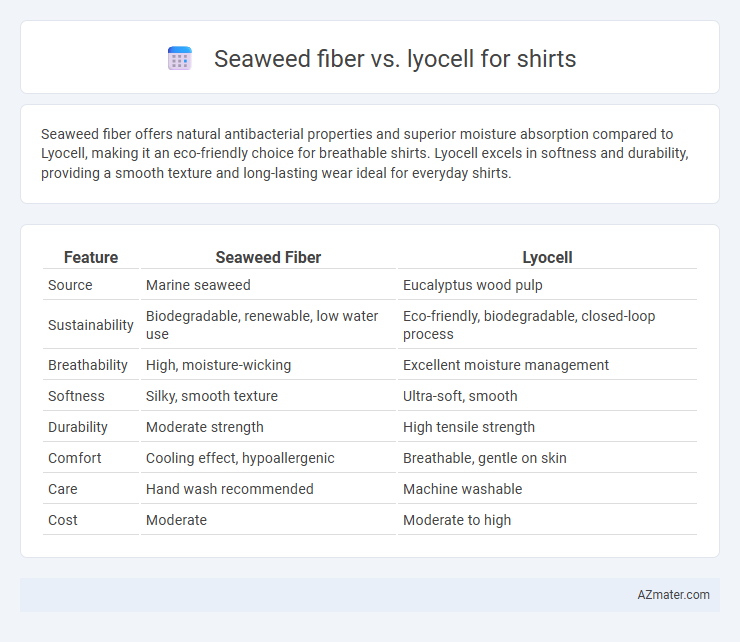Seaweed fiber offers natural antibacterial properties and superior moisture absorption compared to Lyocell, making it an eco-friendly choice for breathable shirts. Lyocell excels in softness and durability, providing a smooth texture and long-lasting wear ideal for everyday shirts.
Table of Comparison
| Feature | Seaweed Fiber | Lyocell |
|---|---|---|
| Source | Marine seaweed | Eucalyptus wood pulp |
| Sustainability | Biodegradable, renewable, low water use | Eco-friendly, biodegradable, closed-loop process |
| Breathability | High, moisture-wicking | Excellent moisture management |
| Softness | Silky, smooth texture | Ultra-soft, smooth |
| Durability | Moderate strength | High tensile strength |
| Comfort | Cooling effect, hypoallergenic | Breathable, gentle on skin |
| Care | Hand wash recommended | Machine washable |
| Cost | Moderate | Moderate to high |
Introduction to Seaweed Fiber and Lyocell
Seaweed fiber, derived from marine algae, is gaining attention for its natural antibacterial properties, biodegradability, and moisture-wicking ability, making it an eco-friendly alternative in textile production. Lyocell, a cellulose-based fabric produced from sustainably harvested wood pulp through a closed-loop process, offers exceptional softness, breathability, and durability for high-performance shirts. Both fibers emphasize sustainability, with seaweed fiber highlighting ocean-based raw materials and lyocell focusing on responsible forestry and low environmental impact manufacturing.
Production Processes Compared
Seaweed fiber production involves harvesting seaweed, extracting alginate, and spinning it into yarn through bio-based methods that emphasize sustainability and low water usage. Lyocell is produced by dissolving wood pulp in a non-toxic solvent in a closed-loop system, which recycles nearly all chemicals and minimizes environmental impact. Both fibers offer eco-friendly alternatives, but seaweed fiber requires marine biomass cultivation, whereas Lyocell depends on sustainably managed forests.
Environmental Impact and Sustainability
Seaweed fiber is derived from marine algae through an eco-friendly process that requires minimal water and no pesticides, making it highly sustainable and biodegradable. Lyocell is produced from sustainably managed wood pulp using a closed-loop process that recycles solvents, significantly reducing environmental pollution. While both fibers offer environmentally responsible alternatives to conventional textiles, seaweed fiber excels in marine ecosystem benefits, whereas Lyocell emphasizes forest regeneration and chemical efficiency.
Fiber Structure and Properties
Seaweed fiber, derived from natural marine algae, features a unique cellulose-based structure with inherent moisture-wicking and antibacterial properties, promoting breathability and skin comfort. Lyocell, produced from wood pulp through a closed-loop solvent spinning process, exhibits a smooth, fine fiber structure that offers high tensile strength, excellent moisture absorption, and biodegradability. Both fibers provide sustainable alternatives for shirts, but seaweed fiber tends to enhance softness and odor resistance, while Lyocell excels in durability and wrinkle resistance.
Comfort and Breathability in Shirts
Seaweed fiber offers exceptional breathability due to its natural moisture-wicking properties, making shirts comfortable in hot and humid conditions. Lyocell is highly breathable and soft, with excellent moisture absorption, providing a smooth, cool feel ideal for sensitive skin. Both fibers excel in comfort, but seaweed fiber has an edge in eco-friendly cooling, while Lyocell ensures durability combined with breathable comfort.
Durability and Care Requirements
Seaweed fiber offers moderate durability for shirts, with natural antibacterial properties that reduce odor and require gentle care to maintain fabric integrity. Lyocell, derived from sustainably sourced wood pulp, exhibits high durability, maintaining strength and shape after multiple washes while being resistant to wrinkles and shrinking. Care for lyocell shirts involves machine washing in cold water with mild detergent and air drying, ensuring longevity and ease of maintenance compared to the more delicate care needed for seaweed fiber garments.
Skin Sensitivity and Allergen Considerations
Seaweed fiber, derived from natural algae, offers hypoallergenic properties that benefit sensitive skin by reducing irritation and preventing allergic reactions. Lyocell, made from sustainably harvested wood pulp, is also gentle and breathable but may contain trace chemicals from the manufacturing process that could affect highly sensitive individuals. For those with skin sensitivities or allergies, seaweed fiber shirts provide a more naturally soothing option with fewer potential allergens compared to lyocell.
Color Retention and Dyeing Capabilities
Seaweed fiber exhibits exceptional color retention due to its natural pigments binding effectively with dyes, resulting in vibrant and long-lasting hues for shirts. Lyocell, derived from cellulose, offers excellent dyeing capabilities with uniform absorption and a wide color palette, but it may show slight fading over time compared to seaweed fiber. Both fibers support eco-friendly dyeing processes, yet seaweed fiber stands out in maintaining deeper, more resilient colors after repeated washing.
Cost and Market Availability
Seaweed fiber shirts tend to be more expensive than lyocell due to limited raw material supply and emerging production technologies, restricting market availability primarily to niche and sustainable fashion brands. Lyocell, produced from sustainably sourced wood pulp through established industrial processes, offers a more cost-effective and widely accessible option in mainstream apparel markets. The growing demand for eco-friendly textiles continues to drive innovation in seaweed fiber production, potentially reducing costs and expanding its market presence in the future.
Best Uses: Seaweed Fiber vs Lyocell in Shirts
Seaweed fiber shirts excel in moisture-wicking and possess natural antibacterial properties, making them ideal for activewear and outdoor use. Lyocell shirts offer exceptional softness and breathability, suitable for everyday casual wear and office attire. Both fibers provide sustainability benefits, but seaweed fiber is preferred for performance-focused shirts while lyocell suits comfort-driven designs.

Infographic: Seaweed fiber vs Lyocell for Shirt
 azmater.com
azmater.com